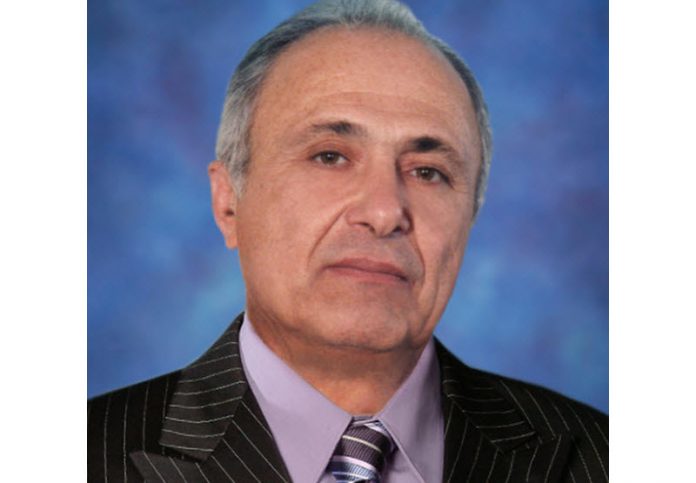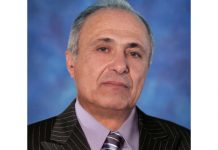See in Russian Below
The Jewish population of Central Asia, before the 1917 revolution in Russia, was almost entirely religious. Religion played a huge role in the life of Central Asian (bukharian) Jews, regulating almost all of its spheres. Many were educated at home or in special primary schools: the Talmud Torah and Cheders. The former were considered community institutions and were intended to support children from low-income families. In them, training was carried out free of charge. Cheders were private schools. The teacher – Melamed received payment from parents for teaching children. Education in schools was two-level: 1st stage for boys aged 3-5 to 9-10 years (“khomlo”); the second stage up to 13 years.
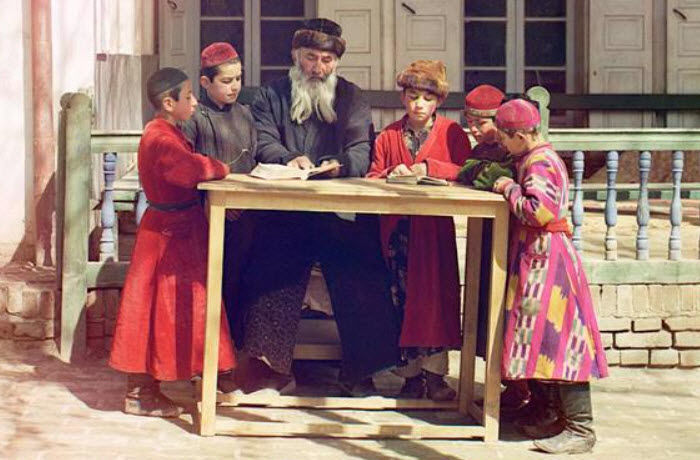 Children study the Torah (photo by Sergei Prokudin-Gorsky)
Children study the Torah (photo by Sergei Prokudin-Gorsky)
Abraham, the founder of the Kimyagarov family, moved from Baghdad (Iraq) to Samarkand at the beginning of the 19th century. He received a Jewish education, knew Hebrew and Aramaic. Abraham was very concerned about the fact that his two sons Yeoshua and Pinchas, as well as grandchildren, were literate, close to religion and brought up in the best Jewish traditions. Specially trained Melamed teachers helped them to master all the wisdom of the Jewish religion, Jewish law and language.
It is known that one of the greatest teachers of the law, Rambam, in his work “Alahot Talmud Torah” (12th century), wrote about the need for Melamed teachers in every country, in every district and in every city. Until the residents of the city appoint Melamed, they are declared “herem” (exclusion from the Jewish community). If there are no houses of teaching for children in the city, it will be destroyed, because the world stands on this: on the breath of the mouth of infants who practice Torah.
Along with the introduction to a certain specialty, Abraham tried to give his children and grandchildren, if possible, a good education. Some of them, having studied at the Cheder, and then at the Yeshiva, became rabbis, shohets, moels, khazans and darshans (interpreters of the Torah). Some chose the path of a teacher – Melamed and devoted their lives to a noble cause – teaching the younger generation to read and write. There were many such people in the Kimyagarov family. For example, the famous Ravs Abo and Nisim Kimyagarov.
Rav Abo, Melamed, expert in Torah and Hebrew language. He organized in his home Cheder – an elementary school for young children 3-5 years old.
Rav Nisim, a Melamed, knew the Torah well, taught at the Cheder in Samarkand, and was also a darshan and khazan in the Beit Knesset.

After the October Revolution of 1917 in Russia, the established educational system was destroyed. In the cities of Central Asia, educational programs (elimination of illiteracy), schools and universities were opened. The teaching of religious subjects was prohibited there. Many Bukharian Jews passed through them and received primary education. In the 1920s, in the cities of Tashkent, Samarkand and Kokand, Bukharian-Jewish schools of the middle and higher level were opened.
In Soviet times, the Kimyagarovs were highly educated. Among them there are many teachers of schools, technical schools and universities. Zalman Abayevich Kimyagarov (1922-1978) was one of the famous teachers of Central Asia, who devoted his entire adult life to educating the younger generation.
Zalman Abaevich is a teacher and educator from G-d, a public figure, one of the prominent representatives of the Bukharian-Jewish community of the second half of the 20th century. Sowers of the reasonable, kind, eternal – they talk about teachers, which fully corresponds to the life and work of Zalman Abayevich. He, as it were, picked up the baton of a teacher and mentor from representatives of previous generations of his kind, many of whom worked in the field of enlightenment and devoted themselves to organizing the spiritual life of Bukharian Jews and teaching children the Torah.
Zalman Abaevich was a prominent figure not only in the Kimyagarov family, but also in the entire community of Central Asian (bukharian) Jews, who reached the top of the Soviet school hierarchy within the educational institution.
Zalman Abayevich began his education in 1929 with a Cheader. After the massive closure of religious schools, in 1931, he continued his studies at the secular school No. 25, which was located in the mahalla (Vostok quarter), in the place of compact residence of Central Asian (bukharian) Jews in Samarkand, from 1843 until the last mass emigration of Jews from the USSR, in 1989.
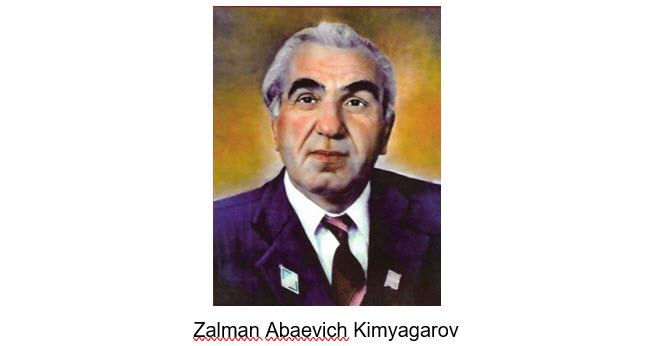
The first stage of his activity is the positions of a pioneer leader and chairman of the student committee (teacher), from which he began to hone teaching skills and climb the administrative ladder up to the director of secondary school No. 26, one of the famous secondary educational institutions of the Vostok quarter, where he worked until the last days of his life. At the same time, Zalman Abayevich had a multifaceted work that covered a huge layer of his various activities – a teacher, organizer, administrator, statesman and public figure.
In his work, from the very beginning, he checked his every step with his teachers, friends and like-minded people, who recognized him as a future leader, which increased his authority every day.
In 1941, after leaving school, Zalman Abayevich entered the one-year pedagogical college. In 1943, in connection with conscription into the army, he had to interrupt his teaching activities. But already in 1944, in accordance with the decision of the USSR Defense and Labor Committee, he, as a teacher, was demobilized. Zalman Abaevich continued to work as a teacher of school number 25. (Director Baturov Aron Pinkhasovich).
His time required educated and knowledgeable specialists. He tried all the time to work on improving his qualifications and political level. In 1946, Zalman Abaevich entered the correspondence department of the Physics and Mathematics Department of the Dushanbe Pedagogical Institute. By that time, he was already working as the head teacher of school No. 25 and he was entrusted with organizing the evening school No. 6, which was needed by demobilized soldiers and working youth. The leadership fully trusted him and he acquitted him.
When in 1951 the question arose about the appointment of a new director of the incomplete secondary school No. 26, the party and state bodies without hesitation appointed Zalman Abayevich to this position and, as later life showed, they were not mistaken. They knew him as a young, talented, purposeful, and able to overcome obstacles, a teacher without prejudice to others, demanding of himself, of every teacher and student.
Already in the first years of work as a school director, Zalman Abaevich radically changed its material and technical base – he reconstructed the old building, added a gym, classrooms, equipped a stage, and also built a new building. All this in the conditions of a total shortage of everything: finance and mainly building materials. Only an extraordinary person like Zalman Abaevich, possessing sufficient courage and remarkable organizational skills, could take such actions under those conditions. He ensured that the school moved from a junior high school to a new level and it was awarded the status of a high school. Hundreds of grateful young men and women were able to get a full secondary education and continue their studies in technical schools and universities.
He took care not only of the school, which he headed, but as a deputy of the city Council of People’s Deputies of several convocations, Zalman Abayevich, gave his organizational skills, gushing energy, assertiveness, natural talent of a diplomat to the cause of improving and raising the level of public education of his district, city and region.
Zalman Abayevich never forgot about his roots, about his place in the Bukharian-Jewish community, of which he presented himself as an integral part. He managed to create an atmosphere of high morality and exactingness in the school among teachers and students in the secular educational process, at the same time secretly preserve and maintain a connection with their spiritual roots in Jewish children. Such behavior, in those years, could be compared to “walking along the edge of a razor blade.” How could such a thing be done in the days of rabid atheism, which is the main part of the state policy of the USSR?
Zalman Abaevich paid close attention to the organization of the educational process, closely followed the level of its methodological support. He has always been the initiator of the introduction of everything new, progressive in the educational process, and first of all, technical teaching aids.
Not a single event in the “Vostok Quarter” was complete without the participation of Zalman Abayevich. Whether the issue of gasification of residential buildings and public buildings, improvement of territories, water supply and sewerage, improvement of people’s life, holding cultural events, holding elections to government bodies or party structures, and much more, it is impossible to list everything. His popularity and immense authority among the population and representatives of higher authorities guaranteed one hundred percent success in any cases he undertook to solve.
Zalman Abaevich possessed an exceptional analytical mind. He was distinguished by a unique ability, it would seem, in insoluble conflict situations, to grope for that remaining thin fertile thread, having strengthened which he eliminated intra-family discord and inter-neighbor conflicts.
Zalmon Abaevich was a simple, modest and highly moral person. He generously sowed goodness around him, demanding nothing in return.
A marble slab is attached to one of the walls of school No. 26 in memory of the great teacher and mentor Zalman Abaevich Kimyagarov.
AMNUN KIMYAGAROV, Candidate of Technical Sciences, Associate Professor, President of the American Branch of the International Academy for the Development of Technology, Inventor of the USSR, Member of the Israel Writers’ Union, Member of the International Association of Creative Intelligentsia
Педагог со знаком качества
Еврейское население Центральной Азии, до революции 1917 года в России, было почти сплошь религиозным. Религия играла огромную роль в жизни центрально-азиатских(бухарских) евреев, регламентируя практически все ее сферы. Многие получали образование дома или в специальных начальных школах: талмуд-тора и хедерах. Первые считались общинными учреждениями и предназначались для поддержки детей из малообеспеченных семей. В них обучение осуществлялось бесплатно. Хедеры были частными школами. Учитель – меламед получал плату от родителей за обучение детей. Учеба в школах была двухуровневая: 1-ая ступень для мальчиков возраста от 3-5 до 9-10 лет(«хомло»); вторая ступень до 13 лет.

Дети изучают Тору(фото Сергея Прокудина-Горского)
Авраам основоположник рода Ким(ь)ягаровых перебрался из Багдада(Ирак) в г. Самарканд в начале19 века. Он получил еврейское образование, знал иврит и арамейский языки. Авраам очень заботился о том, чтобы его два сына Иеошуа и Пинхас, а также внуки были грамотными, близки к религии и воспитаны в лучших еврейских традициях. Освоить все премудрости еврейской религии, еврейского закона и языка им помогали специально подготовленные педагоги- меламеды.
Известно, что один из величайших законоучителей Рамбам в своем труде «Алахот Талмуд Тора» (12 век), писал о необходимости в учителях-меламедах в каждой стране, в каждом округе и в каждом городе. Пока жители города не назначат меламеда, им объявляется «херем»(исключение из еврейской общины). Если не будет в городе домов учения для детей, он будет уничтожен, потому что на этом стоит мир: на дыхании уст младенцев, занимающихся Торой.
Наряду с приобщением к определенной специальности Авраам старался дать детям и внукам, по возможности, хорошее образование. Часть из них проучившись в хедере, а затем в иешиве становились равинами, шохетами, моэлями, хазанами и даршанами(толкователями Торы). Некоторые выбирали стезю педагога – меламеда и посвятили свою жизнь благородному делу – обучению грамоте подрастающего поколения. В роду Ким(ь)ягаровых таких было немало. К примеру известные равы Або и Нисим Кимягаровы
Рав Або, меламед, знаток Торы и языка иврит. Он организовал в своем доме «хедер» – начальную школу для малолетних детей 3-5 лет.
Рав Нисим, меламед, хорошо знал тору, преподавал в хедере в г. Самарканде, также был даршаном и хазаном в бейт-кнессете.
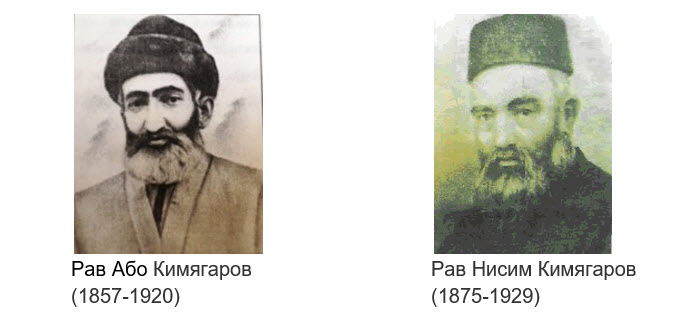
После Октябрьской революции 1917 года в России, установившаяся образовательная система была разрушена. В городах Центральной Азии были открыты курсы ликбеза(ликвидация безграмотности), школы и вузы. В них запрещалось преподавание религиозных предметов. Многие бухарские евреи прошли через них и получили начальное образование. В 1920-х годах в городах Ташкенте, Самарканде и Коканде были открыты бухарско-еврейские школы среднего и высшего звена.
В советское время Кимьягаровы отличались высокой образованностью. Среди них много преподавателей школ, техникумов и вузов. Одним из известных педагогов Центральной Азии, посвятивший всю свою сознательную жизнь воспитанию подрастающего поколения, был Залман Абаевич Кимягаров(1922-1978).
Залман Абаевич – педагог и воспитатель от Б-га, общественный деятель, один из заметных представителей бухарско- еврейской общины второй половины XX века. Сеятели разумного, доброго, вечного – говорят об учителях, что всецело соответствует жизни и деятельности Залман Абаевича. Эстафету педагога и наставника он, как бы, подхватил от представителей предшествующих поколений своего рода, многие из которых трудились на ниве просвещения и посвятили себя организации духовной жизни бухарских евреев и обучению детей Торе.
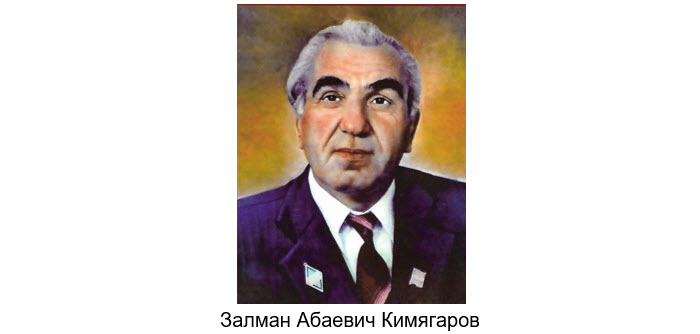 Залман Абаевич был яркой фигурой не только в роду Кимягаровых, но и всей общины центрально-азиатских(бухарских) евреев, дошедший до вершины советской школьной иерархии в рамках учебного заведения.
Залман Абаевич был яркой фигурой не только в роду Кимягаровых, но и всей общины центрально-азиатских(бухарских) евреев, дошедший до вершины советской школьной иерархии в рамках учебного заведения.
Свое образование Залман Абаевич начал в 1929 году с хедера. После массового закрытия религиозных школ, в 1931 году, он продолжил учебу в светской школе № 25, которая располагалась в махалле (квартал «Восток»), в месте компактного проживания центрально-азиатских(бухарских) евреев г. Самарканда, вплоть до последней массовой эмиграции евреев из СССР, в 1989 г.
Первой ступенью его деятельности являются должности пионервожатого и председателя ученического комитета(учком), с чего началось оттачивание педагогического мастерства и подъем по административной лестнице вплоть до директора средней школы № 26, одного из известных средних учебных заведений квартала «Восток», где он проработал до последних дней своей жизни. В то же время у Залман Абаевича была многогранная работа, которая охватывала огромный пласт его разнообразной деятельности – педагога, организатора, администратора, государственного и общественного деятеля.
В своей работе, он с самого начала, каждый свой шаг сверял со своими педагогами, друзьями и единомышленниками, которые распознали в нем будущего лидера, что с каждым днем повышало его авторитет.
В 1941 году в году, после окончания школы, Залман Абаевич поступил в годичный педагогический техникум. В 1943 году, в связи с призывом в армию, ему пришлось прервать педагогическую деятельность. Но уже в 1944 году, в соответствии с решением Комитета обороны и труда СССР, он, как педагог, был демобилизован. Залман Абаевич продолжил работу в качестве педагога школы № 25. (Директор Батуров Арон Пинхасович).
Его время требовало образованных и знающих специалистов. Он старался все время работать над повышение своей квалификаци и политического уровня. В 1946 году Залман Абаевич поступил учиться на заочное отделение физико-математического отделения Душанбинского пединститута. К тому времени он уже работал завучем школы №25 и ему поручили организацию вечерней школы №6, в которой нуждались демобилизованные солдаты и работающая молодежь. Руководство полностью доверяло ему и он оправдал его.
Когда в 1951 году встал вопрос о назначении нового директора неполной средней школы №26, партийные и государственные органы без колебаний назначили на эту должность Залман Абаевича и как показала дальнейшая жизнь не ошиблись. Они знали его как молодого, талантливого, целеустремленного, и умеющего преодолевать препятствия, педагога без ущерба для окружающих, требовательного к себе, к каждому преподавателю и ученику.
Уже в первые годы работы в должности директора школы, Залман Абаевич кардинально изменил ее материально-техническую базу – реконструировал старое здание, пристроил спортзал, классные комнаты, оборудовал сцену, а также построил новое здание. Все это в условиях тотального дефицита всего: финансов и главным образом строительных материалов. Только неординарный человек, как Залман Абаевич, обладая достаточным мужеством и недюжими организаторскими способностями мог в тех условиях пойти на такие действия. Он добился того, что школа из неполной средней школы перешла на новый уровень и ей был присвоен статус средней школы. Сотни благодарных юношей и девушек смогли получить полноценное среднее образование и продолжить учебу в техникумах и вузах.
Он заботился не только о школе, которую возглавлял, но как депутат городского Совета народных депутатов нескольких созывов, Залман Абаевич, отдавал свои организаторские способности, фонтанирующую энергию, напористость, природный талант дипломата делу совершенствования и повышения уровня народного образования своего района, города и области.
Залман Абаевич никогда не забывал о своих корнях, о своем месте в бухарско-еврейской общине, неотъемлемой частью которой он себя представлял. Ему удалось создать в школе атмосферу высокой нравственности и требовательности в среде педагогов и учеников в светском образовательном процессе, в тоже время негласно сохранять и поддерживать в еврейских детях связь со своими духовными корнями. Такое поведение, в те годы, можно было бы сравнить с «хождением по краю острия лезвия бритвы». Как можно было сделать такое, во времена оголтелого атеизма, являющегося основной частью государственной политики СССР?
Залман Абаевич уделял пристальное внимание организации учебного процесса, внимательно следил за уровнем его методического обеспечения. Он всегда был инициатором внедрения всего нового, прогрессивного в учебный процесс, и в первую очередь технических средств обучения.
Ни одно мероприятие в «Квартале Восток» не обходилось без участия Залман Абаевича. Касался ли вопрос газификации жилых домов и общественных зданий, облагораживания территорий, водоснабжения и канализации, улучшения быта людей, проведение культурно-массовых мероприятий, проведение выборов в органы государственной власти или партийные структуры, и многое другое, всего невозможно перечислить. Его популярность и огромный авторитет среди населения и представителей вышестоящих инстанций гарантировали стопроцентный успех любых дел, за решение которых он брался.
Залман Абаевич обладал исключительным аналитическим складом ума. Его выделяла уникальная способность, казалось бы, в неразрешимых конфликтных ситуациях, нащупать ту оставшуюся тонкую благодатную нить, укрепив которую он устранял внутрисемейные разлады и меж-соседские конфликты.
Залмон Абаевич был простым, скромным и высокоморальным человеком. Он щедро сеял добро вокруг себя, ничего ни требуя взамен.
АМНУН КИМЬЯГАРОВ, кандидат технических наук, доцент, президент американского отделения Международной Академии по развитию технологий, Изобретатель СССР, член Союза писателей Израиля, член «Международной ассоциации творческой интеллигенции»


